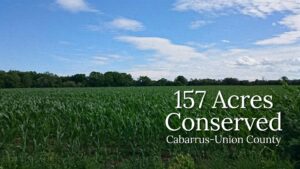
by Ruth Ann Grissom
March 31,2016
I’ve been spending a lot of time in my garden in recent weeks, planting a few more shrubs and adding several new perennials to my backyard meadow. I used to think of my gardening as a somewhat frivolous and selfish hobby, but after reading Bringing Nature Home by Douglas Tallamy, I’ve come to see it as an extension of my conservation work. “Like it or not, gardeners have become important players in the management of our nation’s wildlife,” Tallamy writes in the opening chapter.
There hasn’t been – and never will be – enough public land set aside to sustain wildlife populations. That responsibility now falls to private landowners. The task before us is to supplement and link isolated areas of high conservation value, say the Uwharrie National Forest with Morrow Mountain State Park and the Pee Dee National Wildlife Refuge. Good stewardship can mean restoring habitat on farmland and timber tracts, but also simply including more native plants in our suburban yards.
The plight of the monarch butterfly has heightened awareness of link between wildlife and native plants, but including milkweed in our gardens is just the beginning. In an indirect way, birds also depend on native plants. If we want to sustain populations of our favorite songbirds, we have to do more than stock the feeders in our yards. Many birds devour our black-oil sunflower seeds, but even seed-eaters rely on insects to feed their young. This was a revelation to me, but it makes sense that nestlings would need a richer source of protein. Insects are the basis for the transfer of energy up the food chain. In essence, these herbivores do a miraculous thing – they convert plant material into meat for higher omnivores and carnivores.
Unfortunately, these “little things that run the world” – in the words of esteemed biologist E. O. Wilson – are awfully picky eaters. While a migrating woodthrush might be forced to eat less nutritious ligustrum berries if dogwood berries aren’t available, insects seem to shun exotic plants. Butterflies and moths – as well as beetles, bugs and spiders – are often specialists. If they have evolved to lay their eggs and feed on a particular native plant, they won’t accept a substitute.
As gardeners, we need to rethink our infatuation with plants touted as being “pest-free.” We need to not only tolerate, but celebrate, a few tattered leaves. We need to let our gardens wear them as a badge of honor. Those lacy leaves are an indication our gardens are sustaining a healthy web of life, replicating the native ecosystems that once covered the land where our neighborhoods have claimed.
That said, growing natives doesn’t mean we have to sacrifice aesthetic appeal. Think of the natural beauty of a forest floor carpeted with spring ephemerals or a roadside meadow strewn with colorful perennials in fall. We’re drawn to these landscapes – we don’t view them as lacking. If we choose wisely, a native garden can be just as enchanting as one filled with exotic species.
To help us make good selections, Audubon North Carolina has developed lists of native plants suitable for gardens in each of the state’s three eco-regions. The Piedmont list (http://nc.audubon.org/sites/g/files/amh416/f/50_plants_for_piedmont.pdf) divides plants into four categories: 1) plants that produce seeds and nuts such as goldenrods and maples, 2) those that provide berries such as dogwood and viburnums, 3) nectar sources such as cardinal flower and bee balm, and 4) larval hosts such as spicebush, river birch and paw paw. More than half of the 50 species on this list have already found a home in the garden I started last year.
The list also specifies the moisture level each plant prefers – wet, moderate or dry. If sited properly, native plants are generally easy to grow. The biggest challenge to gardening with natives can be procuring the plants themselves. They’re rarely offered at big box stores. You have to search out smaller, specialized growers and retailers, some of which are primarily online. Audubon North Carolina has also helped in this regard. They’ve prepared a list of sources across the state (http://nc.audubon.org/conservation/find-bird-friendly-native-plants-retailers). The list isn’t exhaustive – I’d advocate for adding Campbell’s Greenhouse, Blackhawk Hardware and Wing Haven in Charlotte and Woodlanders in Aiken, S.C. – but it’s a good place to start.
Audubon North Carolina is highlighting a handful of plants every year (http://nc.audubon.org/conservation/2016-bird-friendly-native-plants-year-list) and then encouraging growers and retailers to offer them and gardeners to plant them. As consumers, it’s up to us to create a demand for these plants. In doing so, we will also help fulfill the needs of wildlife. As Tallamy notes in his book, “It is now within the power of individual gardeners to do something that we all dream of doing: to make a difference.”
For more information about Audubon North Carolina’s Bird-Friendly Native Plants program, go to http://nc.audubon.org/conservation/bird-friendly-communities/bird-friendly-native-plants